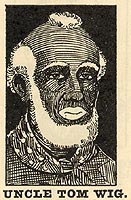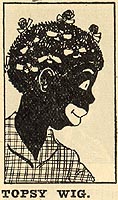
For the Amateur and Professional
Enlarged Edition by Ward MacDonald and Eben H. Norris
Illustrated by Harlan Tarbell
Chicago: T. S. Denison & Company, © 1926

 |
For the Amateur and Professional Enlarged Edition by Ward MacDonald and Eben H. Norris Illustrated by Harlan Tarbell Chicago: T. S. Denison & Company, © 1926 |
 |
 CLICK ON ANY ICON TO SEE ENLARGEMENT |
The titlepage of this 100-page booklet lists the complete title: DENISON'S MAKE-UP GUIDE WRITTEN FOR THE AMATEUR ACTOR AND CONTAINING INFORMATION OF VALUE TO PROFESSIONALS IN THE ART OF MAKING UP FOR STAGE PARTS; ALSO IN THE SELECTION OF WIGS, BEARDS AND ALL KINDS OF MAKE-UP MATERIAL AND ACCESSORIES. It is also a catalogue for the various kinds of make-up materials Denison sells. It is also another way to measure the omnipresence of Uncle Tom's Cabin even in early 20th century American culture. For example, only eight proper names appear in the catalogue: Jiggs, Santa Claus, Uncle Josh -- and Uncle Tom; Marguerite, Martha Washington, Sis Hopkins -- and Topsy. |
| The booklet also catalogues a good deal of white America's preconceptions about race. Claiming to have "spared no pains or expense" to make their Make-up Guide useful, Denison's featured 21 full-page photographs of Mr. Ward MacDonald ("an experienced actor [who] has played nearly every type of character known to modern drama") made up to impersonate a range of characters, mostly ethnic types, or stereotypes, from such categories as: English type, German or Dutch Character, Ghetto Jew, The Japanese, The Irishman, The Chinaman, and American Indian. The photos began with 5 pictures "showing the successive steps taken in making up." Because "blackface minstrel," according to the guide, is "perhaps the part most frequently played by amateurs," you can watch MacDonald "blacking up" in the first five photos below. (19th century minstrels used burnt cork to put on "blackface," but MacDonald is using a tube of Superfine Minstrel Black.) The photo far right, from the character section, shows MacDonald wearing an "Uncle Tom Wig" in the role of an "Old Darky Servant" -- the "theme," says the guide, of "many plays." | |
 |
 |
 |
 |
 |
 |
| There are nine pages of men's wigs, and five of ladies', ranging in price from $11 (Martha Washington) to a dozen Negro Wigs for $9.75. The Uncle Tom wig is on the first of the pages below, and the Topsy wig is on the last. The introduction to these pages says that Harlan Tarbell's "wig illustrations were made directly from the models," and "show graphically just how wonderfully the appearance can be modified and altered." |
 |
 |
 |
| After eight pages of "Beards, Whiskers and Mustaches," the catalogue ends with the following nine pages of "Stage Accessories." Every item but one is intended for use in a minstrel show. |
 |
 |
 |
 |
 |
 |
 |
 |
 |
